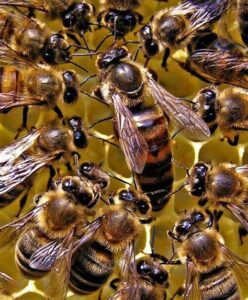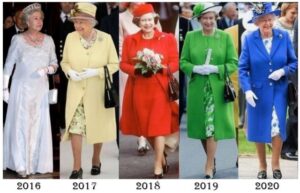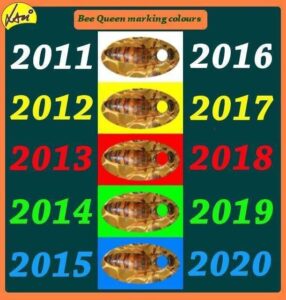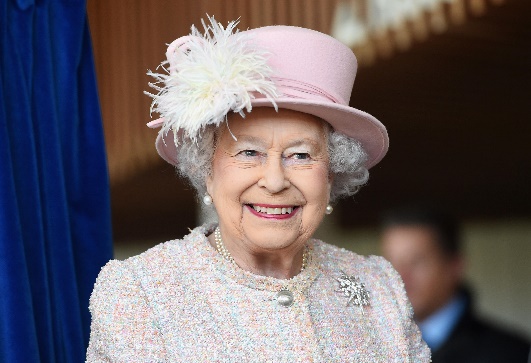As we have been gathering together over the bank holiday to celebrate her majesty Queen Elizabeth’s Platinum Jubilee, it has allowed us to ponder how amazing both our Queen who has ruled our country is, and our queens that inhabit the hives. When I consider her majesty Queen Elizabeth II she has had a presence throughout many generations of my family life. I have fond memories of the commemorative coins given to me in primary school to mark her 25th anniversary, of the mugs we collected with my children for her 50th anniversary and for the celebrations we are enjoying now 20 years later. When I consider my Britishness, I think about afternoon tea, our never-ending inventive quirkiness, and of course our very own Royal Family. They are as much a part of our national identity as curry night and honey cream teas and that influence spreads throughout the world.
If you could imagine our honeybee hives as a world then the queen bee is also at the centre of all things, influencing generations of bees. For every determined female worker bee or observant male drone bee, the queen is at the heart of their existence. She is the only bee in the hive who lays eggs making her a mother to all and it’s her unique pheromone that carries her scent across the comb world on which she walks. The queen pheromone, known as “Queen Mandibular Pheromone”, has a calming effect on the colony. When they sense their queen, the colony knows their future generations are being created and the colony can focus on the business of creating comb and honey. In fact the pheromone itself suppresses the ability of the female worker bees to lay any eggs at all, and in the absence of a queen you can see workers trying desperately to maintain the hive by laying unfertilised male drone eggs. Not great for the future of the colony but at least they get to pass on their genes! There are also moments when you watch a queen at work in the hive, when the whole colony seems to just pause and those around the queen turn to face her. The attending bees spend just a couple of seconds facing their queen, touching her gently and capturing her pheromone to spread to other bees as they progress across the comb in the business of egg laying and brood rearing. 
Every beekeeper learns quickly when a colony has a queen with attitude. Stories abound regarding queens that have produced warrior-style daughters who fiercely protect the hive from any opening and will determinedly chase any unwary beekeeper miles down the road to make their point as to why they should be left alone. It is the temperament of a queen that often has an immediate effect on a colony not just through her genetics, but also her direct influence. When ferocious colonies are in need of a surrogate queen as their own begins to fail, beekeepers will endeavour to find a gentle hearted queen for the colony and the way in which the colony calms in acceptance of their new queen is remarkable. Talking to beekeepers around the farm, we at Quince were once upon a time renowned for ferocious bees and beekeepers would drive miles away from the apiaries, fully suited, before removing their hoods in the hottest of weathers. Fortunately for myself, that time has passed and the introduction of new queens now gives great, meticulous hardworking colonies with a gentler disposition and with the right queen at the heart, all things work well. It is a pleasure to open the hive and discover what’s inside with little fear of repercussions. Finding the right queen makes all the difference!
When we think about the way we announce our queens, for her majesty Queen Elizabeth II we have carriages, crowns, pipers and 21-gun salutes. All the amazing pageantry that surrounds her majesty to proclaim who she is. As much as I would like to tell you the hives do the same thing, I’m afraid I can’t. It’s down to the new queen herself in the hive to announce her royal presence, beautifully shown in this YouTube video clip by Frederick Dunn. From the female egg that is taken from the comb and placed in a queen cup, through to the grub that is fed predominantly on the royal jelly, it is a journey of perils. As the grub is given the royal treatment, it grows rapidly within its cup. It needs to, as the race of succession begins! As a whole group of grubs mature, wrap themselves in silk and start to transform within the cells, there will only be one winner. These growing queens around the colony are endeavouring to win the right to be the one and only queen of the hive. As the day they emerge approaches, the queens start to sing. Their piping calls vibrates through the comb, announcing their presence to all and issuing a battle challenge. Their worker sisters buzz with excitement as the queens’ call to each other and as they emerge into the colony, it’s the strongest and quickest queen that will secure the succession in the hive. Her piping call announces to all her intent and also helps to find her challengers. Whether it’s a quick sting into a queen cell before her rival emerges or the fierce battles seen when two new queens fight, the winner will be queen to the colony. A ruthless but efficient way of creating the best queen for the hive.
As a final thought on our amazing queens, we at Quince Honey Farm mark the passing years by marking little coloured dots on the backs’ of the queen bees so we know how long they have been in charge. The queen colours, modelled brilliantly by our own Queen Elizabeth II below, tell the beekeepers which colours are designated for the year and we mark our own queens accordingly. Whether our hive queens are queens for 2-3 years or reach the grand old age of 5 years, we wish them and our own queen a long and fruitful life and thank them for all the sweetness they bring into the world.
Blog written by Marie Shortt, Head of Education, Quince Honey Farm.



Comments
comments for this post are closed